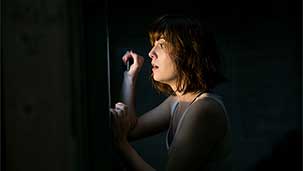You seem to have found your niche in this business. But it’s not (surprisingly) as a director. Rather, you’re someone who seems to excel at matching talent with content and shepherding the whole herd of cats to a (mostly) satisfying conclusion.
Made for a budget of 5 million, 10 Cloverfield Lane is an unique amalgam of low budget indie and slick studio product. It is helmed by first time director Dan Trachtenberg, yet looks and feels nothing like a first effort. With technical and creative support from you and your production studio, Bad Robot, 10 Cloverfield Lane never suffers from the kind of ragged edges low budget films often display. It is well shot, crisply edited, and boasts three strong performances.
10 Cloverfield Lane spends most its time in an underground survival shelter built and occupied by a twitchy former satellite engineer Howard (John Goodman). The shelter has two other occupants Michelle (Mary Elizabeth Winstead) and Emmett (John Gallagher Jr.). Emmett fought his way in while Michelle woke after a car crash to find herself shackled to a water pipe. The rest of the film takes it time exploring exactly what lead to these peculiar circumstances—and how each of the three copes with what they discover about one another, and the truth of their predicament.
This film is one example of how to marry the resources of a studio to a low-budget script, and, in so doing, how to create a workaround for the roadblocks that these kind of films often have to negotiate. It has become a truism that it’s impossibly difficult for original content to find a home anywhere in the studio system, so unless a property has some kind of name recognition it’s unlikely to get green lit. What you managed to do with 10 Cloverfield Lane was produce an original script by marrying the content to an already existing property—in this case the 2008 film, Cloverfield. I have my reservations about this particular model—specifically how much you have to compromise the initial vision in order to include the franchise elements—but it’s certainly a path that seems viable.
There are a few visible seams between what is a self-contained three hander about the particular kind of crazy that leads someone to construct an elaborate bomb shelter—which is then melded with a very different kind of story involving much more expansive themes. The odd mix of humor, tension, and creeping dread is consistently effective. There comes a point in the film where it is not clear at all whether Michelle, Emmitt and Howard are safer inside the shelter, or facing the very real, but not entirely distinct, danger that lurks just outside the door.
There is one caveat, at least for me, in all of this: this film occasionally resembles fusion cuisine that is less than the sum of its parts. Neither beast nor fowl, it has a few moments that feel heavy-handed—especially a kind of overt Chekov’s gun reveal early in the first act. This is how you tried to foreshadow a big turn, but it felt awkward and interrupted the otherwise clockwork rhythm of the film, making the Cloverfield connection sometimes feel like it was grafted onto an original script with more low-key ambitions.
I like Kraft Dinner. And I like Salmon. I’m just not sure I love them mashed together. And while 10 Cloverfield Lane was well crafted throughout, I could never quite shake the feeling that it was as much marketing experiment as clever genre exercise.
It was, all in all, a pretty enjoyable thriller though. And a lot of that success comes from you being smart enough to know exactly where your strengths lie.
Sincerely,

Tim






